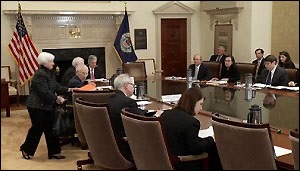By Pam Martens and Russ Martens: June 29, 2016

Fed Chair Janet Yellen Takes Her Seat at an Open Meeting of the Federal Reserve Board of Governors on November 30, 2015 to Vote on a New Bailout Rule
Today, at 4:30 p.m., the Federal Reserve is scheduled to release the second leg of its annual stress tests of 33 banks holding $50 billion or more in total consolidated assets. The first leg of the tests was released last Thursday with all 33 banks getting a passing grade in terms of meeting the minimum capital cushion required. Today’s final round, called the Comprehensive Capital Analysis and Review (CCAR), will determine whether the banks are allowed to continue or increase dividend payments, conduct share buybacks or issue secondary stock offerings. This is the sixth annual round of stress tests conducted by the Fed since the financial crash in 2008.
In addition to the regular stress tests, eight large banks with significant trading and/or clearing operations are required to show losses if a major counterparty defaulted. Those banks are: Bank of America, Citigroup, Bank of New York Mellon, Goldman Sachs, JPMorgan Chase, Morgan Stanley, State Street Corp. and Wells Fargo.
In the data released last Thursday, the Fed showed a total loss of $52.6 billion at all eight banks combined on derivatives, securities lending, and repurchase agreement activities should a major counterparty default. Wall Street veterans are highly skeptical that $52.6 billion captures the reality of the problem when those same banks are holding hundreds of trillions of dollars in notional amounts of derivatives and the tally has grown since the epic crash of 2008.
It’s tough to believe that $52.6 billion would cover the tab because at the big insurer AIG, which received a $185 billion taxpayer bailout in the crash, over half of that amount went out the back door as a stealth bailout of the big banks. A total of $93.2 billion was paid by AIG to Wall Street and foreign banks for their derivative bets and securities loan transactions.
Since the size of the derivative exposure has grown and become more interconnected, why would the losses be expected to diminish in the next crash?
The Federal agency created under the Dodd-Frank financial reform legislation to monitor and research risks across the financial system, the Office of Financial Research, also has its skeptics on how the Fed is measuring counterparty risk in the derivatives arena.
In a March 2016 report, OFR researchers Jill Cetina, Mark Paddrik, and Sriram Rajan, indicated that they see the problem not as what would happen if the largest derivatives counterparty to a specific bank failed, as the stress tests currently measure, but what would happen if that counterparty happened to be the counterparty to other systemically important Wall Street banks. The researchers write:
“A BHC [bank holding company] may be able to manage the failure of its largest counterparty when other BHCs do not concurrently realize losses from the same counterparty’s failure. However, when a shared counterparty fails, banks may experience additional stress. The financial system is much more concentrated to (and firms’ risk management is less prepared for) the failure of the system’s largest counterparty. Thus, the impact of a material counterparty’s failure could affect the core banking system in a manner that CCAR may not fully capture.” [Italic emphasis added.]
The OFR researchers underscore their point further with this:
“The resilience of the core may be overstated in systemic stresses. In particular, shared counterparties may pose large risks to the core even if they are not the most significant on a firm-by-firm basis. Large and collectively shared counterparties, under stress, may concurrently transmit shocks to banks in the core. By identifying the largest collectively shared, or largest core counterparties, one may better differentiate systemic from firm-specific risks.”
The trading behavior of the U.S. global banks last Friday and this past Monday, following the referendum in the U.K. that delivered a voters’ mandate to withdraw from the European Union, further underscores the lack of credibility with the Fed’s stress tests. Morgan Stanley lost 13.5 percent of its equity market capital in just those two sessions or a total of $7.13 billion. Citigroup fared only slightly better. Deutsche Bank, whose U.S. unit is among the 33 banks undergoing stress tests, lost a stunning 22.25 percent of its equity market capitalization in the two trading sessions.
Increasingly, it’s becoming clear that the Fed’s lavish public relations exercise around its living wills and stress tests is just that: a lavish public relations exercise that leaves the systemic risk problem at the doorstep of the taxpayer.

